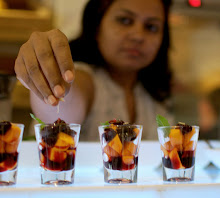Sooran or Zamikand is the name of Elephant foot Yam. It is also called as Oal in Bihar and Bengal.
The problem with sooran is that it looks so ugly people rarely buy it, it also has a reputation of itching your throat if you are cooking the native variety. The native variety has a few small bulbous growth on the surface and the flesh looks a bit more pinkish brown.
Here is a sooran seller in a village market we visited, he has both the varieties. The one that itches more is tastier too and the one that is free of itch is considered useless by some.
The itching sensation is due to the high oxalic acid content in the underground corms but the oxalic acid can be denatured during cooking by using lot of souring agents and marinating the cooked or raw sooran in some sour juices.
The variety I use is the one that doesn't itch. But it is advisable to use some lime juice to the recipe if you want to be cautious. Cooking sooran is not too complicated, the skin can be peeled off easily, then you can chop it in cubes and proceed to make any curry or kabab you wish.
ingredients ...
peeled, rinsed and cubed sooran (yam) 250 gm
chopped onion 1/4 cup
minced green chillies 1 tsp or to taste
minced garlic 1 tsp or to taste
salt to taste
mustard oil (cold pressed) 2 tsp or more. Adding more mustard oil makes this chokha taste almost like English mustard paste.
preparation...
Boil or pressure cook the yam with 1/2 cup of water and salt. Cool down.
Mash along with the rest of the ingredients, drizzle with mustard oil and serve warm, cold or whatever way you like.
Lime juice can be added at the time of serving.
After boiling the yam cubes, all the ingredients can be blended together in a blender jar. That way it makes a nice dip which is quite delicious and creamy on it's own.
This sooran ka chokha is a popular mashed vegetable recipe with the elders of eastern UP and Bihar. I say elders because I have rarely seen youngsters enjoying it the way elders do. Such a pity.
I suggest you stuff it in grilled sandwich along with mustard sauce sometime and see how even the kids love it. The same recipe is known as Kaathalu pitika in Assam.
In fact all types of chokha that we make in UP are known as pitika in Assam. There are some similarities in the cuisine despite geographical separation, local ingredients are used as per convenience.




















This is one vegetable I miss in Brazil.. will definitely try out the chokha when I am in India.
ReplyDeleteTry finding any yam you get Shobha. This will be good with any of those. But yes each yam has a different taste.
DeleteReally appreciate your blog Sangeeta! I love that you focus on eastern UP cuisine and always share some story or tidbit with the recipe. I have some neighbours from east UP and west Bihar, and it's fascinating to me to see the similarities/differences in your cooking, theirs, and our local ways! Thanks for highlighting the beauty and diversity of India and for recording these heirloom recipes. Keep it up.
ReplyDeleteThank you so much K. I find so much wealth in the older traditional recipes I rarely get impressed with the newer cuisines we discover. But is always amazes me how some dishes are cooked almost similarly in different parts of the world. We wont understand the common inheritance of the Earth unless we understand how similar evolution of cuisines we have.
Delete